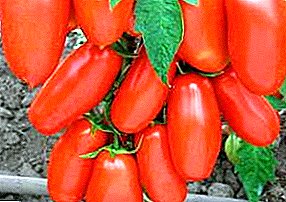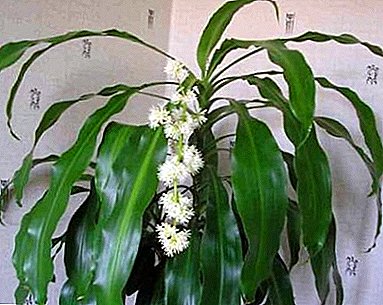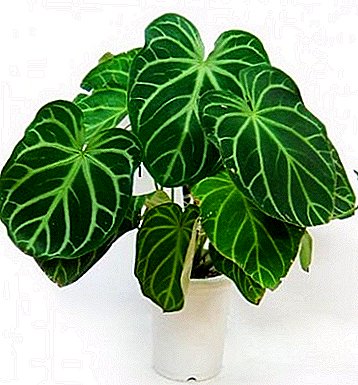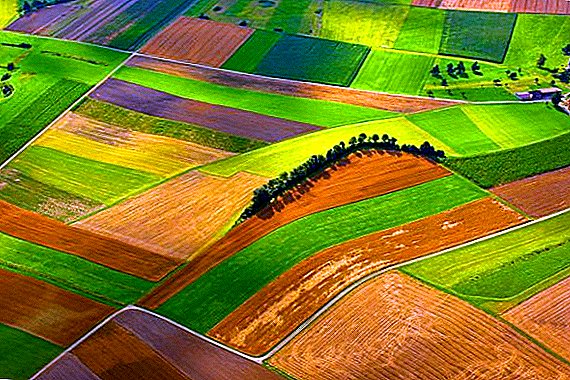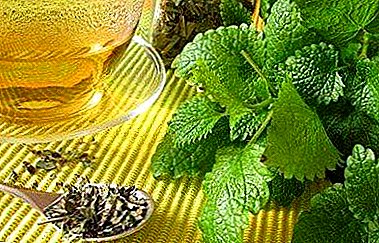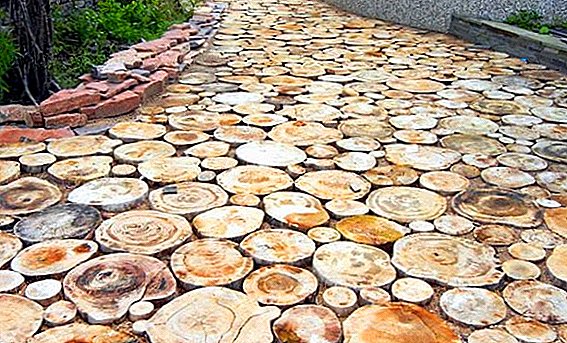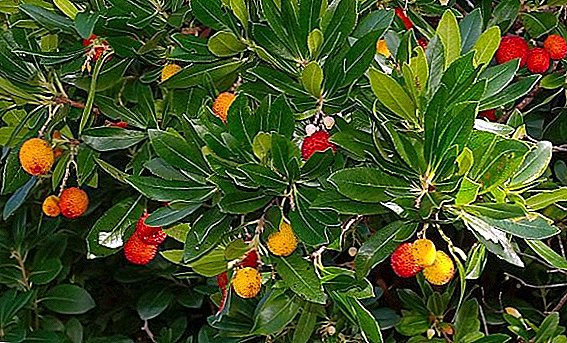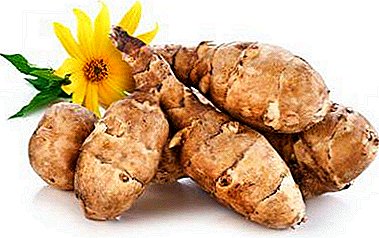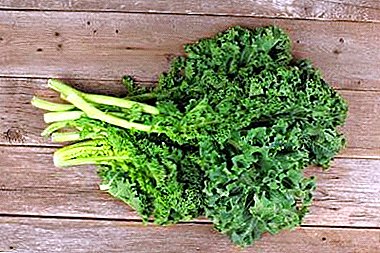
You can rarely meet Kale cabbage on the summer cottage or garden plot. Few know that in addition to the decorative appearance and original taste, it has a huge number of useful properties. In addition, this type of unpretentious, tolerates cold and requires minimal maintenance.
In our article you will read about other names of this vegetable, including learn about Kale cabbage, we will tell you what it is and what are the distinctive features, besides we will present you with a photo of different varieties of leaf plants and their description, as well as you will read how to grow a vegetable plant called Keil and why this cabbage is called Russian.
Detailed description
This plant of the crucifers family has many names: Brunkol, Gryunkol, Brauncol, Keil. Depending on the variety, the leaves form a rosette, are evenly distributed on the stalk or are located on the crown. The tuft is high, reaches more than 1 m in length. The color of leaves from different shades of green to red and purple.
Therefore, this type of cabbage received its distribution primarily as an ornamental plant. The leaf surface is smooth and bubbly, the leaves themselves are crimped or rugged along the edges, depending on the variety. Kale leaves are eaten, crops are harvested several times per season..
History of
This type of cabbage is widely distributed both in Europe and in America. It has not established the exact country of origin. According to scientists, Kale is the most ancient species of wild cabbage. In Russia, the popularity of gardeners began to acquire relatively recently.
What is the difference from other species?
Distinguish cabbage Kale from the usual white can be quite easily on the leaves. They become curly, like a salad immediately after the appearance. Therefore, seedlings of these species are difficult to confuse. In addition, Kale is different in color, does not have a wax coating. The main feature of the cabbage is that it does not form heads, regardless of the variety.
For what purpose is suitable cultivation?
Kale cabbage is quite widely used in cooking.. Salads, soups are made from it, it is stewed, vegetable cocktails and even chips are made, and also consumed fresh. In addition, the cultivation of cabbage cale is possible for decorative decoration of the site.
Advantages and disadvantages
Positive traits:
 unpretentiousness;
unpretentiousness;- resistance to temperature extremes, heat, cold, frosts;
- unique content of nutrients and vitamins;
- high yield;
- variety of varieties;
- suitable for all regions;
- decorative appearance;
- disease resistance.
The disadvantages include:
- the need for frequent watering;
- poorly tolerated transplant;
- has contraindications in use;
- needs feeding;
- light-loving.
Benefit and harm
Proteins, fats and carbohydrates
100 g of cabbage Kale contains 3.3 g of proteins, which is half the daily dose for the body. Excellent meat substitute, which is absorbed better. The carbohydrate content is 8 g, fats are present in the amount of only 0.7 g. Also, dietary fiber is included in the composition, which have a beneficial effect on the digestive system.
Vitamins
Kale contains a large amount of vitamins. A and beta-carotene - indispensable for the eyes and vision, group B - help with anemia, normalize blood sugar levels, C - stimulates the immune system, as well as K and PP, which remove toxins, protect vessels and participate in metabolic processes.
Micro and macro elements
Calcium content in Calais is higher than in milk, while it is absorbed by the body much better.. In addition, the composition includes:
- phosphorus;
- sodium;
- zinc;
- iron;
- manganese;
- selenium.
An important role for the skeletal system is played by potassium, magnesium, which supports the nervous system and heart muscle. Copper is present in sufficient quantity, which helps to maintain the strength of blood vessels and bones. A feature of this type is the content of omega - 3, which are valuable for the body fatty acids.
Calorie content
Cabbage Kale is recommended by nutritionists as one of the unique herbal products to stabilize weight.. Its caloric value per 100 g is only 50 kcal.
F1 subport
Redbor

Hybrid variety of leaf plants redbor, has a red-purple color. The leaves are curly, openwork. Reaches 90 cm in height. Lateral leaves grow intensely, which contributes to more frequent harvesting during the season. Frost-resistant variety withstands drops to -15about WITH.
We recommend to watch the video about the features of Redberry cabbage kale:
Tuscany

Leaf Tuscany is also called Tuscan cale. The leaves are long, elongated, dark green, bubbly, elastic and dense. Externally similar to the leaves of Savoy cabbage. Frost-resistant variety can withstand a drop to -15about C. High yield.
We recommend to watch a video about the features of cabbage Kale varieties Tuscany:
Tintoretto

Leaf vegetable subport - Tintoretto is suitable for cold regions. It tolerates temperature fluctuations, yields yield from +25 to -16about C. The leaves of this green kale, strongly curly, resemble bubbles. The ripening period is medium.
Step-by-step instructions for planting and care
Where and for how much seed can be purchased?
Leaf vegetable seeds are widely represented in specialized stores, departments, retail outlets. Online stores provide an opportunity to purchase varieties of not only Russian, but also foreign selection directly from foreign manufacturers. The cost depends on the number of seeds in the package and the company, from 50 rubles for 6-10 pieces.
Sowing time
Kale cabbage grows in 70-90 days, does not tolerate the transplant, so it’s better to sow it right into the ground. This is done in April - May, landing time depends on the climatic conditions of the region and temperature.
Choosing a place
Suitable sunny areas or with a little shading. Place for planting should be smooth or elevated, in the lowlands possible stagnation of water, it will adversely affect the plant. It is necessary to observe crop rotation and not plant where radishes, rutabagus and cruciferous were previously grown. Plots fit after potatoes, onions, cucumbers.
What should be the soil?
The soil should not be too acidic. Landing place is better to prepare in the fall.. For this purpose, slaked lime, chalk, wood ash are added to the soil, humus is added. In the spring before planting fertilized with organic substances.
Landing
Planting seeds produced in the wells. The distance between them should be from 45 cm. Add humus, wood ash to each hole. At a depth of 1-2 cm in the wells placed up to 4 seeds. They need to lightly sprinkle with earth, pour and cover with film.
After 5 days, when shoots appeared, covering material should be removed, and cabbage should be thinned. In each hole there is only one strongest seedling.
Next young cabbage needs the following care:
 Temperature. It is necessary to sow the seeds when the air warms up to +5 C, however, Keil can withstand both heat and cold. Therefore, the timing of its landing is different for each region. She transfers from +35 to -15about C. The most favorable temperature regime from +10 to +20.about WITH
Temperature. It is necessary to sow the seeds when the air warms up to +5 C, however, Keil can withstand both heat and cold. Therefore, the timing of its landing is different for each region. She transfers from +35 to -15about C. The most favorable temperature regime from +10 to +20.about WITH- Watering. This type of cabbage needs constant soil moisture. Watering must first be under the leaves, then into the grooves. In hot weather, watering is necessary daily, while you need to make sure that the water does not stagnate. The leaves in the heat also need to be moistened.
- Top dressing. Recommend to feed Calais after 6-8 weeks, as the harvest. Excess fertilizer can cause leaf rot, so this is often not worth doing. Usually, mullein, wood ash, superphosphate and others are used.
Other vegetable care measures
Necessary activities:
- loosening - after watering;
- weeding;
- hilling - once every 10 days;
- pest prevention;
- timely removal of damaged leaves.
Harvesting
The leaves can be consumed after the cabbage has grown more than 20 cm in height. You can cut individual leaves or completely remove the tip. This is done several times during the season. Overripe leaves become bitter and tough.
Storage
This type of fresh cabbage can be in the refrigerator for a week. Freezing is suitable for longer storage. Up to six months in the Kale freezer does not lose its taste and beneficial properties.
Diseases and pests
Subject to diseases of the species: kila, powdery mildew, white and gray rot, etc. The control measure will be treatment with a permitted fungicide such as Topsin-M, Hom, etc. Also can harm slugs, weevils, cabbage flies, aphids and other insects.
For the fight and prevention is better to use non-chemical and folk remedies.:
- spraying infusions of onion peel, wormwood;
- dusting wood ash and tobacco dust and others.
Board: A good prevention is the planting of a number of plants that repel pest odor: mint, marigold, saffron, etc.
Prevention of various problems
Growing this type of cabbage should carefully monitor the condition of the leaves. The rotted and wilted should be removed so that they do not attract pests. It is important to avoid drought and excessive moisture. For this, the soil around can be mulched.
Kale curly cabbage does not require special complex care, can grow in any climatic conditions and is very useful. Able to give several harvests per season until the cold. At the same time, a beautiful appearance will make it a decoration of the site.


 unpretentiousness;
unpretentiousness; Temperature. It is necessary to sow the seeds when the air warms up to +5 C, however, Keil can withstand both heat and cold. Therefore, the timing of its landing is different for each region. She transfers from +35 to -15about C. The most favorable temperature regime from +10 to +20.about WITH
Temperature. It is necessary to sow the seeds when the air warms up to +5 C, however, Keil can withstand both heat and cold. Therefore, the timing of its landing is different for each region. She transfers from +35 to -15about C. The most favorable temperature regime from +10 to +20.about WITH